Collaged Fashionistas
This week’s post is dedicated to collaged fashionistas – fun paper dolls. It’s for all of us who love to get art inspiration from the world of textiles and fashion.

I have been practicing surface pattern design daily this month and got quite a lot of patterns already. Of course, all of them are not so great and need more work, but I have really enjoyed challenging myself. I have experimented with all kinds of media – watercolor painting, line drawing, collage, and digital tools too.

The more my computer gets filled with these designs, the more I want to see how they look when used. After all, a surface pattern is nothing without a surface to put it on!
So I printed some on paper and wrapped a couple of books. I also gathered some handmade stuff just to see how well digital designs fit with my handmade world.
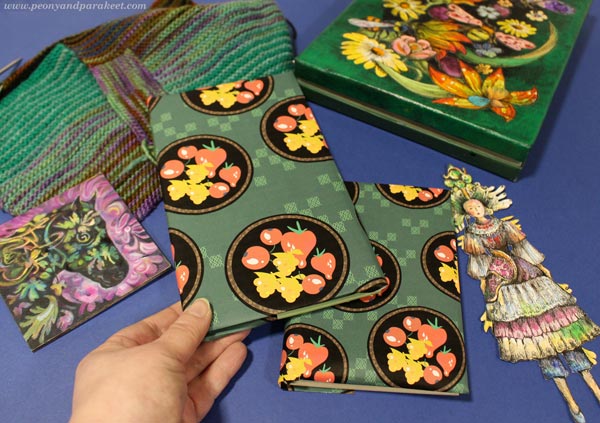
But I wasn’t satisfied at all. Books felt too flat. I needed a figure – a model to dress!
Collaged Fashionistas in Paper
After taking the photo of the books, I remembered someone who would be perfect for it. I created her – or should I say cut her – in 2014. Back then, I used to run art journaling classes in a local scrapbooking store, and I had an idea about a class where we would draw fashion items like clothing, jewelry, and such. But the class was scheduled for May which is a busy month for Finnish women, and it never took place. However, I made an online class called Collageland four years after this idea, and it was also one of the seeds for the class Magical Inkdom. So never underestimate those preliminary ideas that don’t seem to fly off right away!
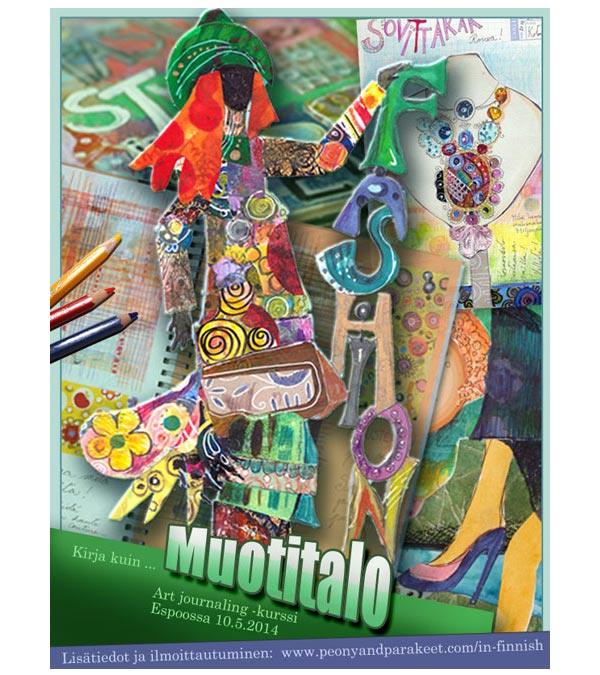
And now I wanted to hire that fashion-obsessed fashionista to showcase my patterns! I wondered if she would still return my calls but phoned her anyway.
“Hi Myriad, are you still modeling?”
“Oh, hi, yes – if it’s for real this time,” she said. “And I want shorter hair!”
“I’ll make you bald,” I promised.
So I cut a new Myriad and I really like what those seven years have done to her!
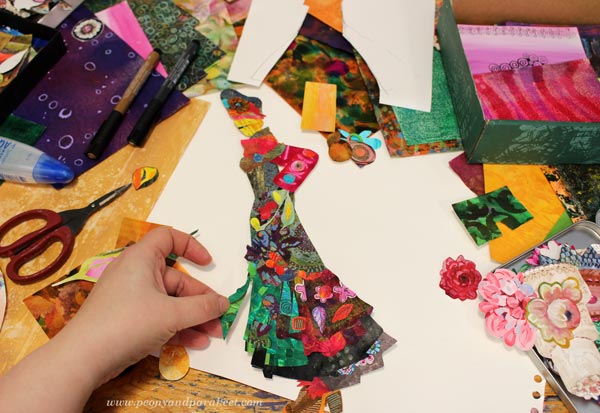
A Living Doll Gets Back to Fashion
“I like the boots,” she said. “But the skirt feels so heavy!” But she wore it without further complaints because that’s what models do. They get all kinds of silly wraps around them and just keep posing no matter what.
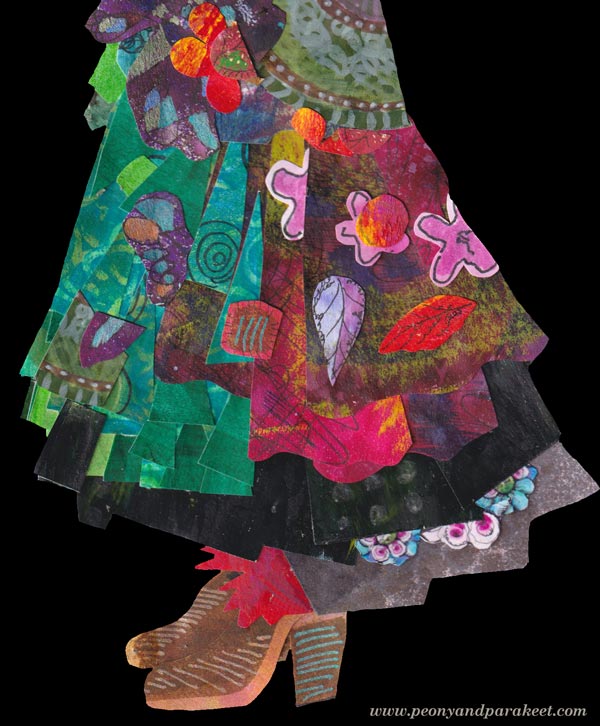
“These boots make me want to go for a walk!” she said joyfully. And so she stepped into one of my paintings like she would own the view.
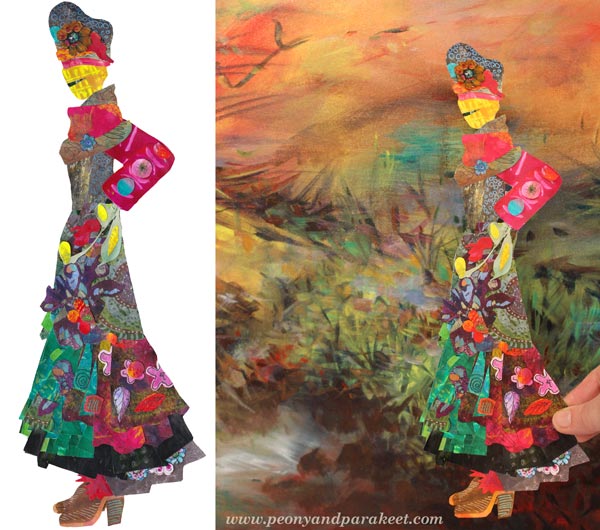
“This is fine art,” I said to her. “Models like you don’t belong in these kinds of paintings.”
“Oh nonsense,” she responded. “This is a windy Siberian meadow, and it’s just perfect for the shoot. What kind of clothes do you have?”
I had a lot to show her but here’s one project that may interest you especially. Last year, I made a surface pattern in watercolor.

I wasn’t fully pleased with it but I had stored it anyway. This week, I made some leaf motifs in illustrator and mixed them with the pattern, and it looks like batik now. I wanted Myriad to wear this!
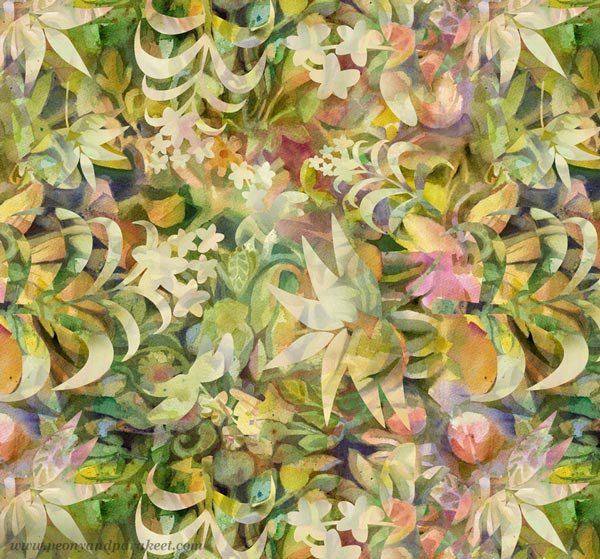
From Paper to a Digital Fashion Model
To get the pattern on Myriad, I made a new version of her in Adobe Illustrator. I marked different parts in different colors and layers so that I could dress her in Adobe Photoshop.

I added some shadows and additional effects and put the painting that I made last year in the background with some blurry effects so that the clothes would stand out.

Here’s a closeup of the watercolor design. Her cheerful scarf has hand-drawn motifs.
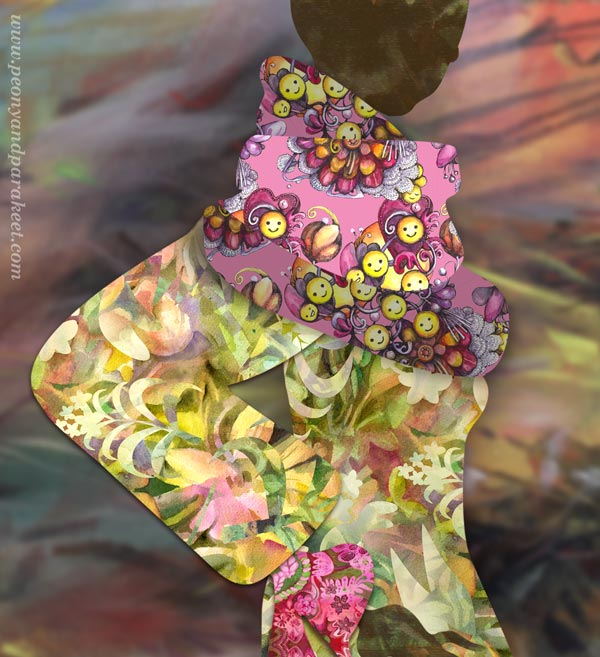
And here’s a closeup of the skirt and shoes that have a pattern too.
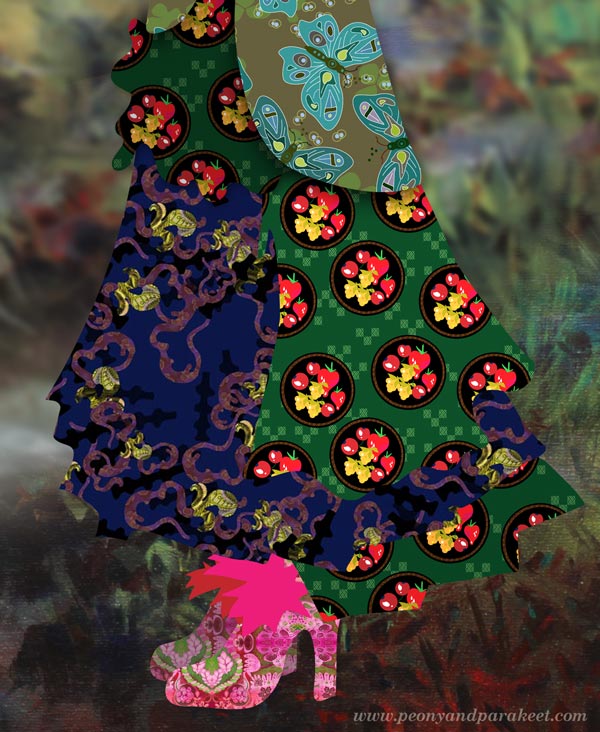
My planner for 2021 has a quote from Kandinsky: “There’s no must in art because art is free.” To me, it means challenging myself. That after all that I have learned in the last seven years, I can still feel the same freedom as a beginner. And that if we push ourselves creatively, our world keeps expanding and we accept more than one technique, or one style, or one truth. Art is never about absolute rights or wrongs because art is free. As a teacher, I find this reminder especially important.
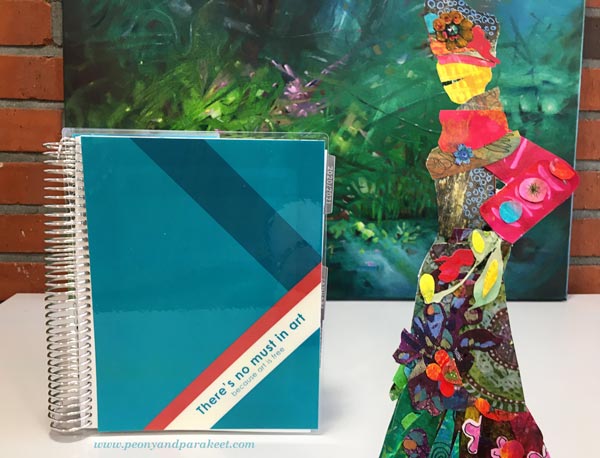
Making collaged fashionistas have brought many more ideas of how I can display my designs! More of them in the future posts.
Annual Birthday Sale for the Illustrator in Us

I love fine art, but life gets heavy if it’s filled with that only. I believe that behind every artist, there’s an illustrator too. The one who likes to play and smile, and say it in a way that everyone gets it, children included. So this year’s birthday sale is dedicated to the illustrator in us. If you have ever considered this or taking these online classes, now is the time!
Animal Inkdom
Normally 79 EUR, now 59 EUR (about 72 USD).
>> Buy Now!
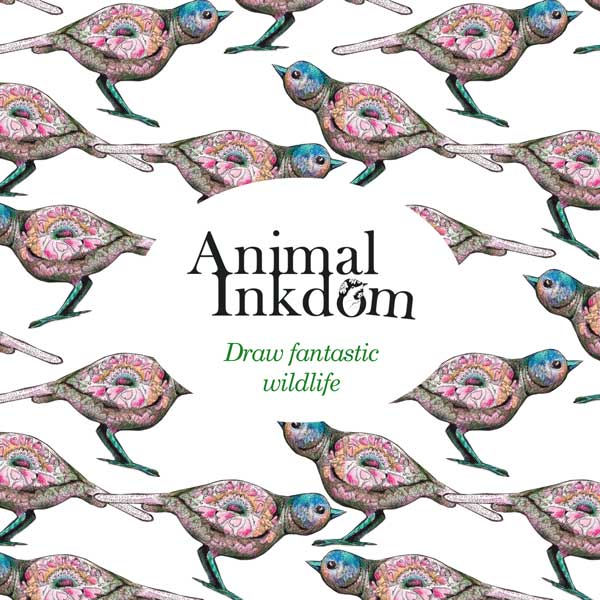
Draw Fantastic wildlife – buy now!
Magical Inkdom
Normally 59 EUR, now 49 EUR (about 60 USD).
>> Buy Now!

Draw cats, fairies, wonderlands – buy now!
Decodashery
Normally 50 EUR, now 39 EUR (about 48 USD).
>> Buy Now!
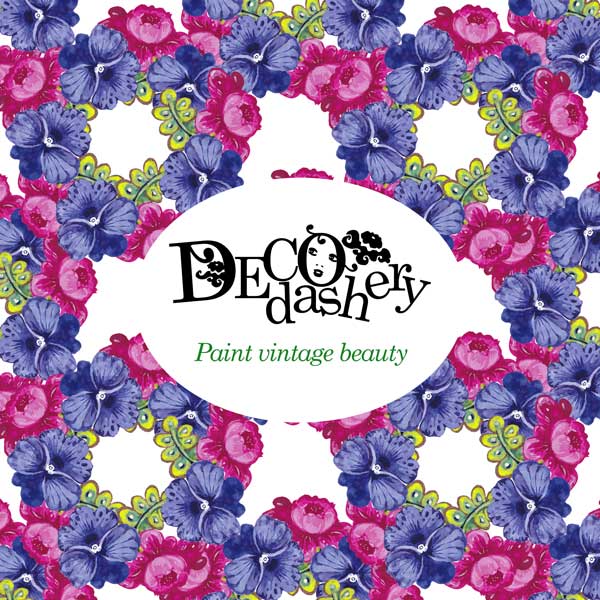
Paint vintage beauty – buy now!
The sale ends on Valentine’s Day, Feb 14th, midnight PST.
Let’s keep smiling, dreaming, and making it all visible too!
Three Design Styles, a Gelli Plate, and a Brush
One of my goals for this year is to learn surface pattern design. I want to move back and forth between art and design, and add more design to this blog as well. This week, I picked three of my favorite designers and played with Gelli Plate to imitate their style. These don’t replicate any of their work, just their style.

Three Designers from Three Centuries
My three favorite designers are Tricia Guild, William Morris, and Wassily Kandinsky.
Tricia Guild a designer from the UK, and she has a company Designer’s Guild, and I have been her fan since the 1990s when I discovered her book Design and Detail. It’s been my interior design guide for 30 years, and all my homes have got ideas from that book.
William Morris is also English, but he lived earlier, in the 19th century. Two rooms of our home have curtains designed by his company, and I regularly admire their clever repeats and ornamental shapes.
Wassily Kandinsky was more of an artist than a designer, but he taught designers in a famous Bauhaus art school in the early 20th century. For me, he is the father of modern design. I see his paintings in the works of most midcentury modern designers. Lately, he has felt even closer, when I have been built a class Floral Freedom that is based on his and Paul Klee’s teachings.
Who are your favorite designers?
Three Designers – Three Color Palettes
I have always liked making hand-decorated papers. Actually, my most popular blog post is this ancient one: How to Make Your Own Patterned Paper from 2010. So let’s get back to basics and make some!
First, I painted the backgrounds with acrylic paints and a flat brush. This set a color palette for each paper.
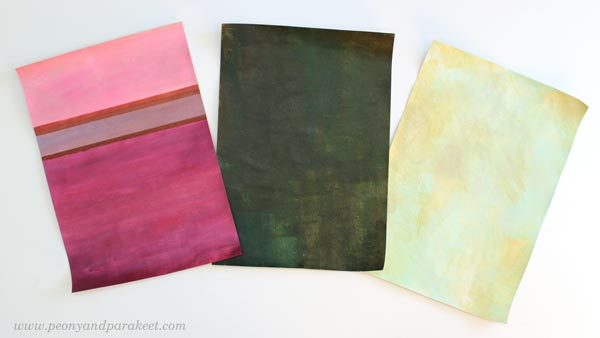
Muted pastels and rich darker tones remind me of Tricia Guild. She often uses stripes or checks too. William Morris has greyish colors and many of his designs have dark backgrounds. Wassily Kandinsky often had a very light background in his paintings.
Three Design Styles – Three Kinds of Shapes
I continued each of the papers by mono-printing motifs with a Gelli Plate. For Tricia Guild’s style, I used a small plate and painted the motifs with a brush on a plate, then pressed the plate on the paper. Because Tricia’s style is often quite relaxed, there was less pressure for perfect outlines.
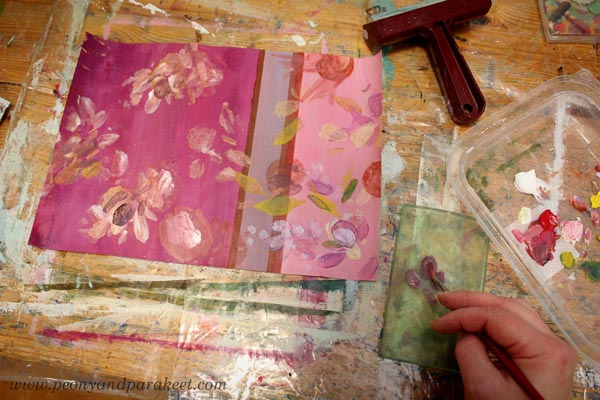
William Morris’s designs are very sharp and ornamental. I cut out ornaments freehand from paper and used both negative and positive shapes. I used both a big Gelli Plate and a small one.

Here’s how the paper looked after mono-printing.

Wassily Kandinsky’s shapes are mostly geometric, so I cut templates that had circles, lines, squares and triangles.

Here’s how the paper looked after mono-printing.
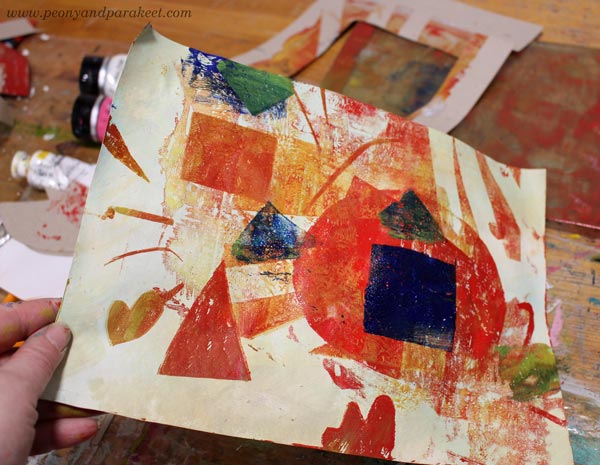
Three Design Styles – Three Levels of Detail
After mono-printing, I finished the papers by painting. I used a narrow brush and made small tweaks only.
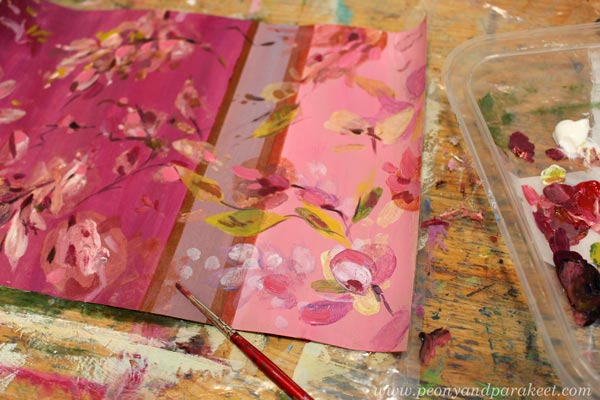
I like Tricia Guild’s designs because there modern meets classic and historical. They feel luxurious, but still comfortable. They don’t require similar perfection from the space than William Morris’s designs. So I didn’t perfect every shape or line, just added a bit more realism to the floral motifs. Here’s the finished paper.
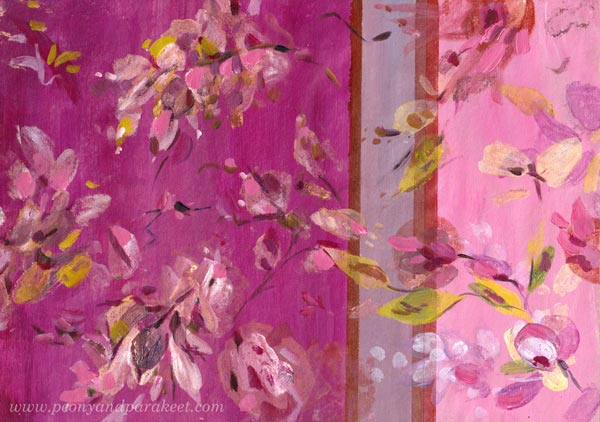
William Morris’s designs are full of outlined motifs, and I connect them with books. “For people who have a library,” I wrote in a notebook that I keep for studying. But I quite liked my mono-print, and didn’t want to stiffen everything. So I only outlined a part of the motifs, and added some small dots and thin lines inside the shapes.

Here’s the finished paper. I really like the big yellow motif! Maybe that could be a part of my future designs.
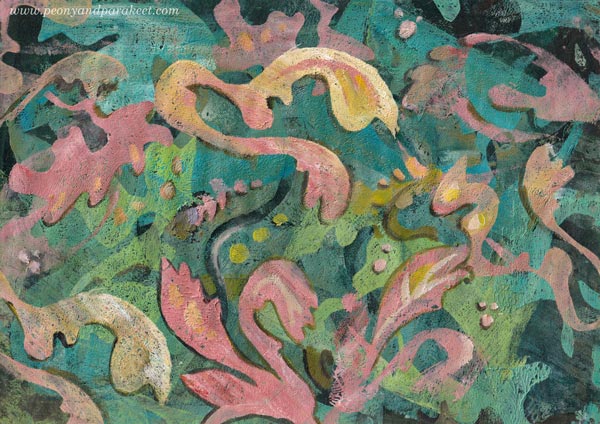
Wassily Kandinsky’s work didn’t lack details either. But if William Morris is for bookworms, then maybe Wassily is for systematic thinkers – for more scientific than humanistic introverts, and for those who love mathematics.
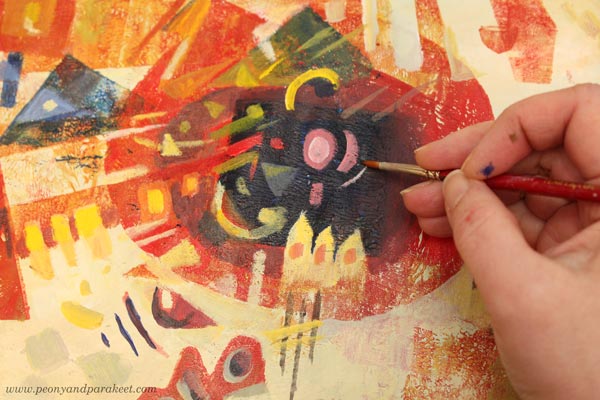
I used the monoprint as a foundation for the composition of shapes and followed Wassily’s advice and ideas from his book Point and Line to Plane, the book that I teach in the class Floral Freedom as well. Here’s the finished paper.
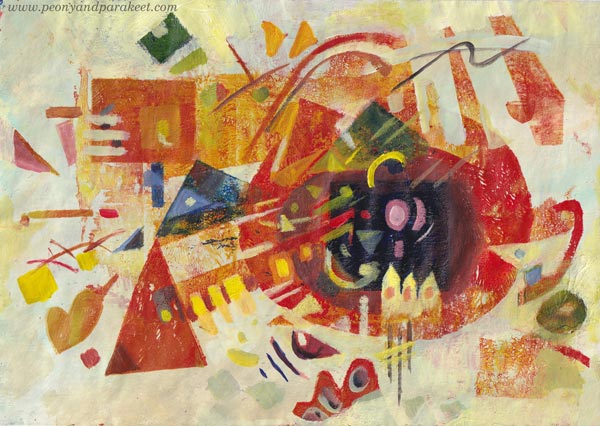
Three Wallpapers
I wanted to see how these papers could work as repeats. I didn’t have time to play with the repeats properly, but here are some quickly made images to demonstrate how the motifs would look in a smaller scale, for example, as a wallpaper.
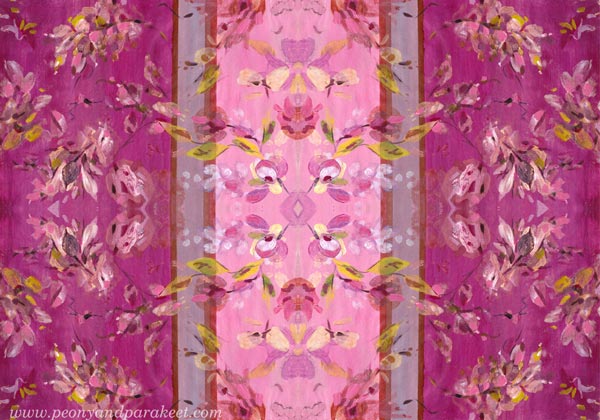
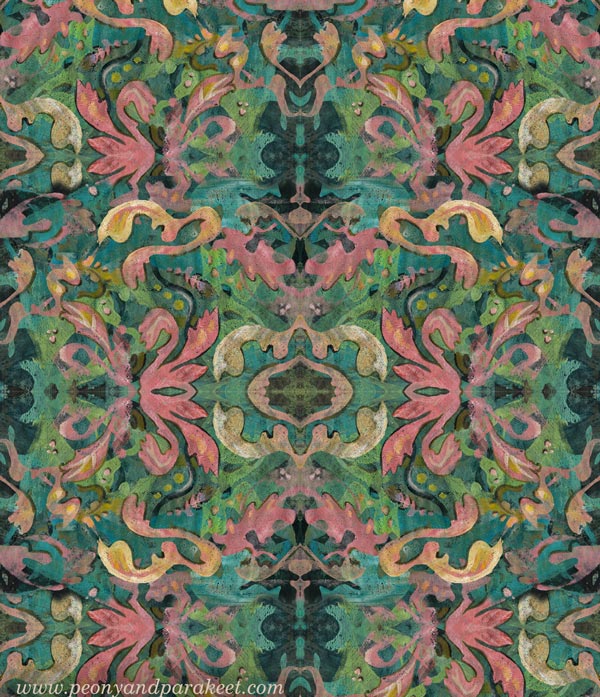

It was a full day, but I had fun making these! Tell me, which three designers would you pick?
Artistic Growth – From “Huh” to “Wow”
This week, we’ll talk about changing artistic direction and how the first reaction doesn’t always matter as much as the second one.
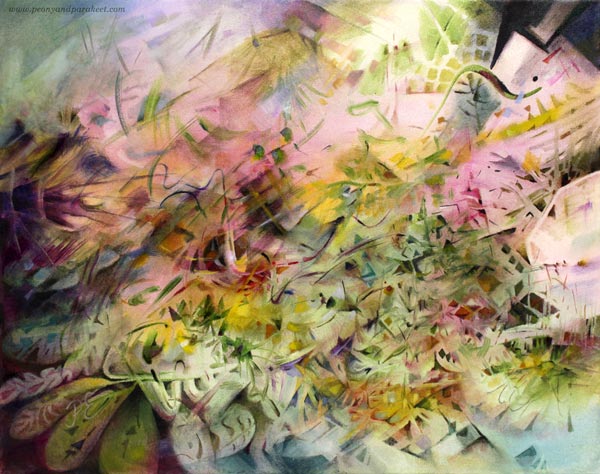
My seed idea for this painting was slightly different from usual, and I wanted to see how it would grow on canvas. It took many sessions and lots of struggles with finishing. “There’s still something wrong with this painting, Paivi,” I said to myself after correcting a couple of shapes that my husband pointed out. Last night, I had a dream that I walked an ugly dog on a thin leash. The breed was an odd choice, but the dog was still mine.
“Huh” and “Wow” – First and Second Reactions
Isn’t it so that we want to change, but as soon as we begin to see the results, we are likely to bounce back? It’s so easy to say: “No, this is not for me, I’ll try something else. I’ll try a different style, a new technique, another art class, or find other artists to follow and admire.” And this is not only a bad thing. In the long run, bouncing back is about integrating the new stuff into our natural self. But in the short run, it can prevent the growth we want and need.
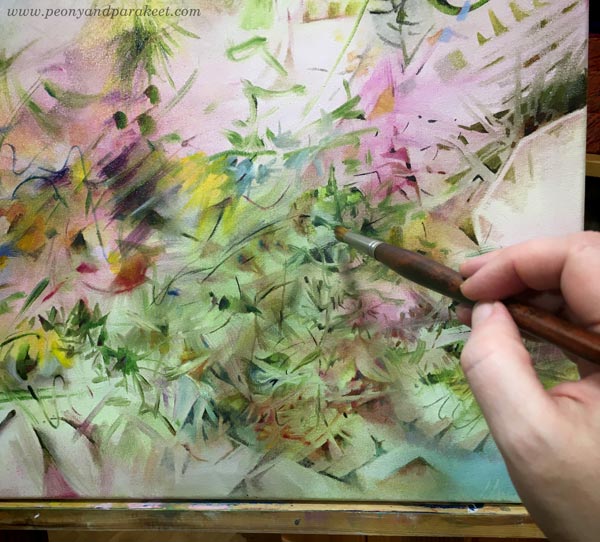
I have been reading James Victore‘s Feck Perfuction as an audiobook. It’s a book about creativity and easy listening about things that are really tough in practice. It’s more like a two-hour inspirational speech than a down-to-earth guide, but it feels current with this painting. In the book, James Victore refers to an American pop artist Edward Ruscha. He has said: “Good art should elicit a response of ‘Huh? Wow!’ as opposed to ‘Wow! Huh?'”
This week, my favorite video podcast, One Fantastic Week, talked about “Instagram art” – pictures that the Instagram algorithm likes. It’s colorful, easy to consume and comprehend, but its exposure doesn’t ensure the artistic quality.
Artistic Growth and New Truths
When a painting is not for a class or a specific exhibition, I try not to think about the audience too much. I trust that you will pick what you like, and forgive me those you don’t.
But with this painting, I realized that I have played in the “Wow! Huh?” category, and this one tries to be more “Huh? Wow!” And that change makes me uncomfortable. It’s like I have been written a revealing story but in a code language, being afraid that anyone who stops to look will see to the core of me. And at the same time, worrying about that anyone who doesn’t, only sees a mess.
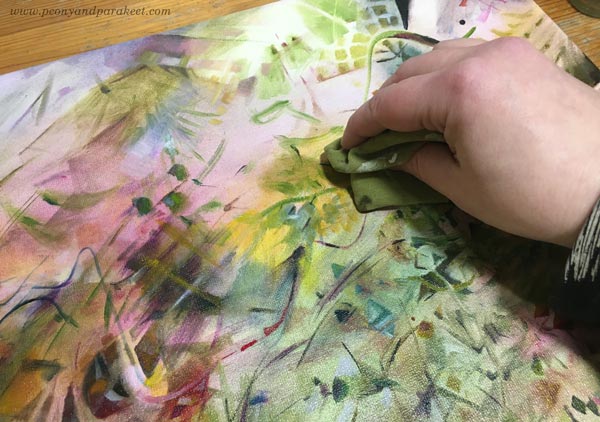
An Outside View to the Inside World
Teaching art has helped me to grow as an artist a lot. For example, when I get to see a student sharing a wonderful painting saying: “I don’t know about this one,” my gut reaction is then: “What!? This is beautiful!” But what’s “huh” for them is “wow” for me because I see the painting in a context that’s still new to them. They haven’t got used to seeing themselves like that. They are in the middle of a change, and it’s tempting to get back to the same old thing.
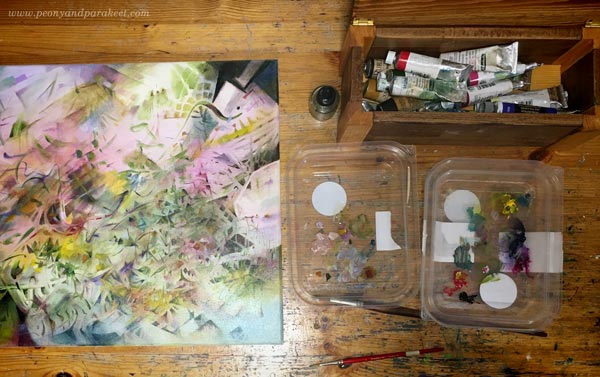
I recycle plastic lids and use them as palettes.
But when we do something regularly, it’s natural to miss the change. Floating on the surface isn’t enough anymore, and we get curious what’s deeper – “behind the glass” as we say in Floral Freedom, referring to Wassily Kandinsky‘s teachings. Then we need to learn, stretch, and redefine. Accept new truths.

When looking at the mirror, I see more wrinkles than before. What was “huh” some years ago would be “wow” now. But with this wisdom, I hope long life for this painting. That the “huh” that it causes now will be “wow” someday. Maybe after I have fully accepted that my artistic growth is towards more and more abstract art.
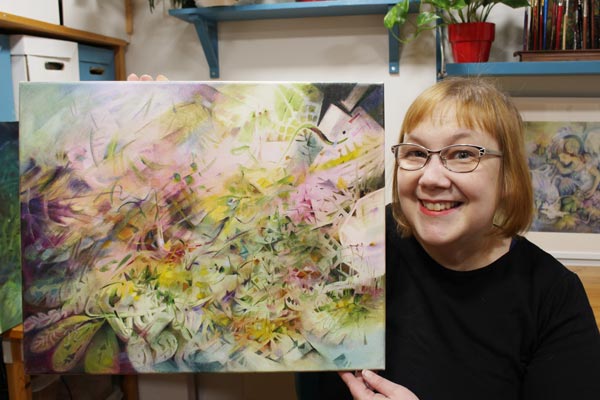
It’s also good to accept that some paintings are just “huh-huh” and a few manage to be “wow-wow,” and what’s “huh” for some is “wow” for another. What do you think?